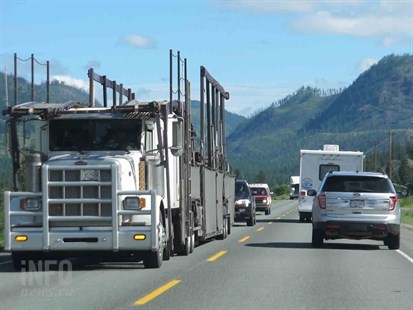
Highway speed limits are set to increase in B.C. beginning today, July 2, and new regulations around snow tires and slow moving vehicles are also being introduced.
(JENNIFER STAHN / iNFOnews.ca)
July 02, 2014 - 12:49 PM
THOMPSON-OKANAGAN - Three highways will see speed limits increase to 120 km/h today and another 1,300 km of highways will see the increase later this summer.
Over 9,100 km of highways were surveyed during a Rural Highway Safety and Speed Review and Minister Todd Stone says several key points are now being addressed — speed limits, winter tires, slow moving vehicles and wildlife collisions.
Stone says the review showed support for speed increases in the same stretches where 85 per cent of drivers are already driving faster than the posted speed limits.
“Properly set speed limits help to encourage safe driving behaviour,” he says, adding the new maximum speed limit in the province will be 120 km/h.
The 10 km/h increase will take affect today, July 2, on the Coquihalla Highway, the Okanagan Connector, Highway 1 and Highway 3. The remainder of the changes, which will mostly be in the Southern Interior, Lower Mainland and Vancouver Island, will be made over the summer.
The ministry is also trying a new pilot project that will see variable speed limit zones on a section of Highway 1, the Coquihalla and the Sea to Sky Highway. Speed limits will change depending on things such as traffic volume and weather.
“These changes will hopefully reinforce to all drivers to drive for the conditions,” Stone says. “Remember posted speed limits are the maximum under ideal conditions.”
Other changes coming out of the review include clarification and new signage for winter tire regulations, as well as a change to the timeframe winter tires are required. The province is reducing the requirement by a full month to the end of March since few winter related collisions occur in April.
Better enforcement, signage and road markings for requiring drivers to keep right except to pass will be utilized and a pilot project on Highway 4 will see drivers require to pull out if more than five vehicles are lined up behind them.
The province is also looking to improve signage and public education to help reduce the number of wildlife collisions around the province.
The review included a survey as well as assessment of 9,100 km of highway. There has been a 28 per cent decrease in serious collisions since 2003 and Stone attributes much of that reduction to new vehicle technology, improved enforcement, increased penalties and education as well investments in provincial highways.
To contact a reporter for this story, email Jennifer Stahn at jstahn@infotelnews.ca or call 250-819-3723. To contact an editor, email mjones@infotelnews.ca or call 250-718-2724.
News from © iNFOnews, 2014